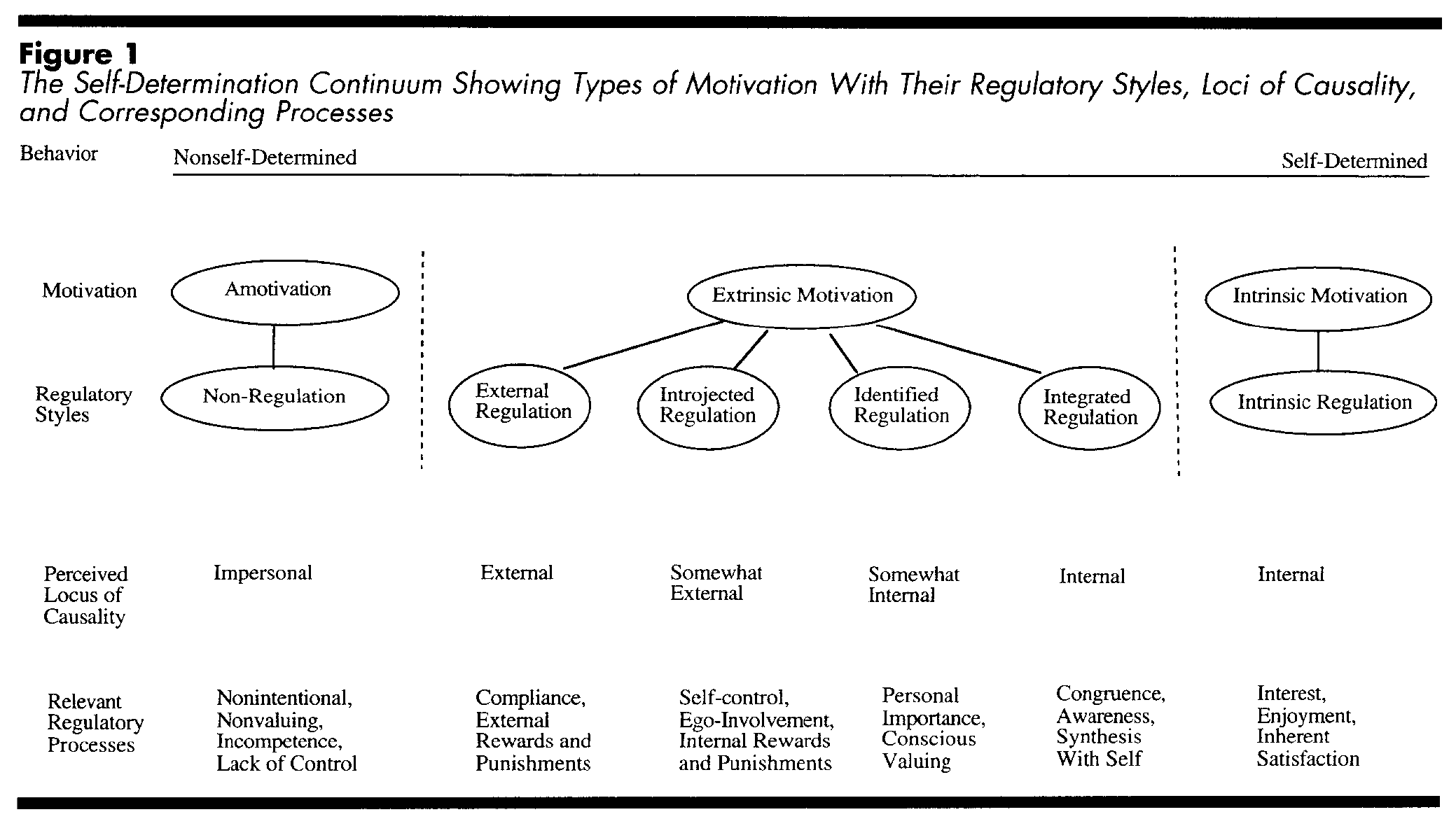Ryan 2000 - Self-Determination Theory and the Facilitation of Intrinsic Motivation, Social Development, and Well-Being
Ryan, R. M., & Deci, E. L. (2000). Self-determination theory and the facilitation of intrinsic motivation, social development, and well-being. American psychologist, 55(1), 68.
This was a very well-written article. It is clear and logical in its flow. It cites convincing research in favor of its argument. I can see why it has so many citations.
Summary
Self-determination theory (SDT) seeks to explain intrinsic motivation, self-regulation and well-being by proposing three innate, psychological needs - competence, autonomy, and relatedness. Motivation deals with both activation and intention. Its end result is the production of specific outcomes. Motivation can either be intrinsic or extrinsic. Intrinsic motivation “refers to doing an activity for the inherent satisfaction of the activity itself.” Extrinsic motivation refers to doing an activity in order to achieve a specific outcome.
Cognitive evaluation theory (CET), a subtheory of SDT, contends that social-contextual events that lead to feelings of action-specific competence (like feedback and rewards) strengthen intrinsic motivation for that specific action. Positive feedback strengthens intrinsic motivation, while negative feedback weakens it. The feelings of competence must also be accompanied by feelings of autonomy in order for intrinsic motivation (i.e., the action cannot be perceived as being forced upon the subject). Extrinsic rewards erode intrinsic motivation (as shown by Festinger because the action is chosen because of the reward and not strictly based on the agency of the subject. Intrinsic motivation can instead be strengthened by allowing for choice, acknowledging feelings, and giving opportunities for self-direction. Not all activities can be intrinsically motivated. The best candidate activities will “hold intrinsic interest for [the subject]” and have “the appeal of novelty, challenge, or aesthetic value.”
Though a person might initially do an activity for extrinsic reasons, SDT allows for a spectrum of extrinsic motivation through which a person might progress. Organismic integration theory (OIT), another subtheory of SDT, presents the different forms of extrinsic motivation and the specific contextual factors that encourage internalization and integration. Internalization refers to a person’s believing of a value (taking it in), while integration refers to their making it part of their own values (fitting it in - “grasp that meaning and synthesize that meaning with respect to their other goals and values”). On the far end of external motivation is amotivation, a state where no action is taken. On the other end is the previously detailed intrinsic motivation. In between lie four different stages of extrinsic motivation, of which external regulation is the closest to amotivation. External regulation refers to behavior that is undertaken strictly to fulfill a demand or earn a reward. These demands or rewards are felt to be “controlling.” A step up in terms of volition is introjected regulation, which is “taking in a regulation but not fully accepting it as one’s own.” Motivations for introjected regulation could include avoiding guilt or anxiety or attaining ego enhancements like pride and feelings of worth. Regulation through identification, the next most volitional level of extrinsic motivation, occurs when a regulation is consciously considered and accepted as important to the individual. Integrated regulation happens when a value or regulation has “been evaluated and brought into congruence with one’s other values and needs.” At this point, the only thing separating the motivation from true intrinsic motivation is that the behavior or regulation is still undertaken to achieve a specific outcome rather than for the inherent satisfaction of the action itself. As people progress from one stage of extrinsic motivation to a more internalized and integrated stage, their actions will feel more autonomous, or more in line with their own internal reasons and desires. This process towards internalization and integration can be facilitated by relatedness (see [Baumseister Year] (todo: link to Need to Belong), which the authors also cite). Feelings of competence also enable this progression.
These three psychological attributes (autonomy, relatedness, and competency) are innate needs. Without them, well-being cannot flourish. Intrinsic goals that relate directly to these attributes (such as being part of a community and personal growth) result in higher states of well-being (as measured by various factors - see p. 75) than do extrinsic goals that indirectly relate to these attributes (such as attaining wealth or fame or image).
Application
Parents who support autonomy in their children are more likely to have intrinsically motivated children. Teachers who support autonomy in their classrooms are more likely to have students who are curious and desire challenges (they also get better student evaluations). Finally, this has serious ramifications for workplace design and mental health. When a person spends 40 hours a week in a position that doesn’t satisfy all of these needs, it is likely to have serious ramifications on their work performance, turnover, and well-being (both in work and outside of work).
